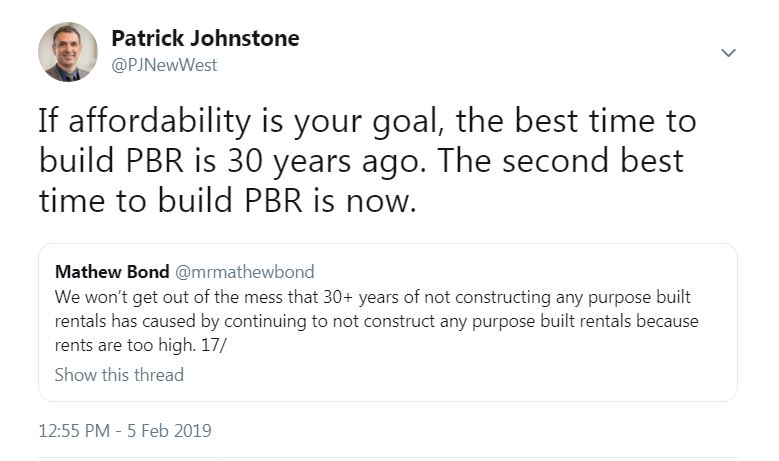It was a big agenda on April 29th, and I’m crazy busy, so I’m going to try (and I’m going to fail) to keep this short. I’ll skip over the daytime workshop stuff, which I can hopefully cover later and get right to the evening agenda.
We started with a Public Hearing:
Heritage Revitalization Agreement (218 Queens Avenue) Bylaw No. 8064, 2019
The property owner of a fairly large property in Queens Park wants to enter into a complicated Heritage Conservation Area agreement where two heritage homes are move to the back of his property and the main heritage home on the site is preserved for perpetuity. The only real variance from the existing zoning bylaw is that the resultant two “back” lots will be 5651 Square feet, which is 6% smaller than the zoning allows.
The Community Heritage Commission support it, the APC support it, no-one sent any correspondence or came to speak to the application. Council approved giving the Bylaw third reading.
Zoning Amendment Bylaw (1005 Ewen Avenue) No. 8103, 2019
There is an empty lot at one of the entry points of Queensborough – between Howes Street and the firehall, that has been vacant for a very long time. It was hard to develop because of some site constraints, especially related to access to the site and the proximity to the firehall.
It has taken some time to find the right fit for this site. This proposal would permit the construction of 23 townhouses and a commercial building. It would also improve the streetscape for pedestrians along Howes street and fill an notable gap in the community entrance. APC support it, Design Panel support it, QRA had no opposition, no-one sent us correspondence or come to the Public Hearing to speak to the application. Council moved to give the application third reading.
Zoning Amendment (886 Boyd Street) Bylaw No. 8100, 2019
The City’s electrical utility needs to build a new substation in Queensborough. We have the land, we have the financing, but now we need to amend the language of the zoning Bylaw to allow an electrical substation in the M-1(light industrial) zone. No-one wrote or showed up to voice opposition, so the city moved to give the amendment third reading.
Zoning Amendment Bylaw (M5 Zone Text Amendment) No. 8101, 2019
Metro Vancouver’s water utility needs to build a tunnel portal at the foot of Quebec street. They have the land, they have the financing, but now they need us to amend the language of the zoning Bylaw to allow a public utility infrastructure installation in M-5 (light industrial) zoning. Again, no-one came to speak to the matter or sent us correspondence on it, and Council moved to approve the amendment.
We then had an Opportunity to be Heard:
Temporary Use Permit No. 00019 for 488 Furness Street
The townhouse development in Queensborough want to operate a sales centre out of their first buildings, which does not comply with the residential zoning, requiring a Temporary Use Permit to allow it to happen. This is not an unusual ask, but several members of the neighbouring community asked that Council review the parking requirements.
Honestly, I find the “we need our garages to store our stuff, so the City needs to provide street parking” argument not compelling, but there is a point in that a commercial enterprise operating, even temporarily, in a residential neighbourhood, should be responsible in how their parking needs impact their residential neighbours. Council moved to approve the TUP on the condition that parking that would berequired as per the zoning is accommodated onsite.
I then had a couple of resolutions to go to UBCM, which I think I will hold off to talk about later, because this is already going to be too long. But the short versions are here, and they were both approved by Council:
Motion: Declaration of Employee Compensation as Part of Annual SOFI Reporting
Therefore be it resolved that the Financial Information Act be amended to permit local governments to report salaries and expenses in their annual SOFI report by job title as opposed to employee name.
Motion: School Bus Safety
Therefore be it resolved that UBCM call upon the BC Ministry of Education and the BC Ministry of Public Safety to mandate that all buses transporting students in British Columbia be equipped with three-point seatbelts, and institute programs to assure those belts are used; and
Be it further resolved that UBCM call upon Transport Canada to require all road vehicles designed for the purpose of transporting students within Canada be equipped with three-point seatbelts.
The following items were moved on Consent:
Uptown New Westminster BIA Parcel Tax Bylaw and
Downtown BIA Parcel Tax Bylaws
The City as two (well, two and a half) Business Improvement Areas. These are commercial areas that agree to have a self-imposed tax to fund their own business development programs. The City facilitates this by collecting the tax and turning it over to the BIAs, but the money is 100% from the BIA members and 100% returned to the BIAs. Every year we have to pass a Bylaw to set the agree-upon rates.
As an aside, this is another one of those weird areas that make it hard to compare the finances of different cities. The $400,000 we collect from the BIAs and turn right back over to the BIA is counted as tax revenue and spending in the City’s financial statements, though this really isn’t city money. Comparing between cities, no-one ever asks if those cities have many or few BIAs.
Municipal Security Issuing Resolution #7842
The City got authorization through Bylaw in 2016 to borrow up to $28 Million for various infrastructure improvements, including the Library and City Hall improvements. To the end of 2019, we anticipate spending $22Million of this as these projects move forward. We want to move this into long-term debt with the Municipal Finance Authority which requires a Resolution.
Community Centre Infrastructure Loan Authorization Bylaw No. 8073, 2019
Building the replacement of the CGP is going to require us to take on more long-term debt. We don’t yet know what the contribution will be from Federal Infrastructure Grants, but (in the strange world of intergovernmental grant finance) we have to demonstrate our ability to do the work without a grant if we wish to receive a grant. So we need to authorize borrowing at a level that assumes we will receive no grant assistance at all.
This will be another Alternate Approval Process thing that I hate, but is the only path given us under the Local Government Act aside from running an expensive and divisive referendum. If enough people report opposition to this borrowing, we will have a referendum. If you don’t think we should borrow to replace the CGP, then between May 2nd and June 10th, you should come to City hall and issue your opposition formally. Notices will be going out through the regular venues.
2019 Tax Rates Bylaw for rescindment and re-reading
The numbers we had in our Property Tax rates bylaw were incorrect due to an administrative SNAFU. The Metro Vancouver mill rates were incorrectly transposed. So we need to rescind the reading and do it again with the right number so Metro can get paid.
Approval of the Scope of Work for a Committee Review
The City has over 30 Advisory Committees, Commissions, and Task Forces. Though an important public engagement tool, they eat up a lot of time and resources, both for City staff and for the volunteers from across the community who take time out of their lives to contribute to community building this way. We owe it to them and to the community to periodically review how these resources are being used and to explore opportunities to make them work better.
The academic lead from SFU who helped us put together our large Public Engagement strategy (and who therefore has intimate knowledge about how it is structured) is being brought in to oversee the review. It will include reviewing successes and stresses in other communities, discussion with committee members, and general public engagement. We can hopefully put some solid policy together to evaluate the effectiveness of our committees. I expect there will be some uncomfortable discussion (“Hey, *my* committees are the most functional ones!”) but it is important that we remain honest and accountable in how we work, and I look forward to this.
Recruitment 2019: Committee Appointments (EAC, NTAC)
On an almost related topic, we are appointing a couple of new members to committees.
Queen’s Park Heritage Conservation Area: Special Limited Category Study – Phase Two Update
During the Queens Park heritage conservation area work over the last couple of years, we identified 84 properties (out of the ~700 in the conservation area) which were put under temporary protection until we could determine better where they fit in the heritage spectrum between the highest and the lowest heritage value. Some eventually had their protection reduced, as they were found to have limited value, and 48 were found to have higher value and were moved on to further study. This is an update report on that process, and next steps.
1209 – 1217 Eighth Avenue: Rezoning and Development Permit for Infill Townhouses – Zoning Amendment Bylaw No. 8099, 2019 for Two Readings
This is recommendation from our LUPC that we give first and second reading to a townhouse development in the Moody Park / West End neighbourhood. This would convert 5 lots that currently have 5 houses into 22 family-friendly ground-based townhouse units.
It would go to a Public Hearing on May 27, so I will hold my opinions until then.
The following items were Removed from Consent for discussion:
Pattullo Bridge Seismic Upgrading: Request for Construction Noise Bylaw Exemption
Translink wants to install some equipment on the existing Pattullo bridge, and need an exemption to our Construction Noise Bylaw to do it. Councillor Das raised some good points about the efforts for public consultation, as the permit length is quite long, and we may ask TransLink to do a little more directed outreach to let residents know which actual days they will be working.
Soil Deposit and Removal Regulation Bylaw No. 8106, 2019
What is more exciting than an update to the City’s Soil Deposit and Removal Bylaw!? This will hopefully help the City reduce the mis-location of contaminated soils and reduce the spread of invasive and noxious weeds. Maybe that’s not exciting for you, but this is what I do for a living!
The only point I had for staff was that we might want to expand our definition of invasive species beyond the provincial Noxious Weeds list –neither Himalayan Blackberry or Scotch Broom are listed as noxious in the province, nor is English ivy. If you go to any invasive species pull in the region, these are the species we see the most of. I also had a few concerns about the Ministry’s current Soil Relocation Policy Paper, as I don’t want to move a Bylaw that doesn’t jive with the most recent Ministry regulatory framework. These are details that can be worked out before final adoption, so council moved to approve first reading.
We did the regular Bylaws dance, which included adopting the following:
Five-Year Financial Plan (2019 – 2023) Bylaw No. 8104, 2019
One of the final steps in our annual budgeting process is the adoption of the financial plan. Now adopted. It’s the law of the Land. Again, more blog posts to come out about this again, as a Mayoral candidate is back on social media saying “New West has the highest taxes in the region”, and that is patently and demonstrably false, but Zombie ideas never really die.
Street Naming Bylaw No. 8045, 2019
Two new streets in Queesnborough now have names.
Finally, we had a big piece of New business
Motion: Indigenous Truth and Reconciliation
Councillor Nakagawa brought forward a motion that provides some direction on our reconciliation process that in summary says:
THEREFORE BE IT RESOLVED
THAT Mayor and Council be provided with training to understand the legacy of residential schools and colonialism; and
THAT all City staff attend mandatory training on the history and legacy of residential schools; and
THAT the City undertakes research to better understand the historical actions of the City as they relate to First Nations; and
THAT the City undertakes research to understand which Nations have a relationship to this land; and
THAT the research respects and incorporates the experiences and stories of the First Nations that claim the territory upon which New Westminster is built to ensure that the history is not told from a colonial perspective; and
THAT the final report be shared with the National Centre for Truth and Reconciliation; and
THAT the City provides opportunities for the community to learn the history and legacy of colonialism in New Westminster; and
THAT the City establish a formal territorial acknowledgement built from the information learned from First Nations during the research process; and
THAT the territorial acknowledgement be approved by First Nations that claim the territory prior to its formal adoption by the City.
THAT City staff report back to Council with an implementation plan for above listed actions.
I am not opposed to any of the actions listed here, but did oppose the motion because I felt it was a little out of step with the ongoing work we have already started in regards to reconciliation. This Council has committed to taking an informed and respectful approach to reconciliation. We have endorsed the Calls to Action, and have tasked staff with creating an outline towards completing that goal. We have agreed to, and have put resources towards, the development of a communication and relationship-building process, such that all parties are welcomed to share their experience and their vision for Reconciliation. We have hired a consultant to guide us through this difficult process, recognizing that we have little experience in-house at this, and we want to do it right.
In my opinion (and this was not supported by a majority of council) the motion was in parts redundant to work the City is already doing, and in parts overly prescriptive towards operational details while staff and our consultants are establishing best practices to achieve the goals this city has put out. Respectfully, the Councillor and I disagree on process, not on goals. Council moved to endorse this motion.
And that was the evening! See you all next week!
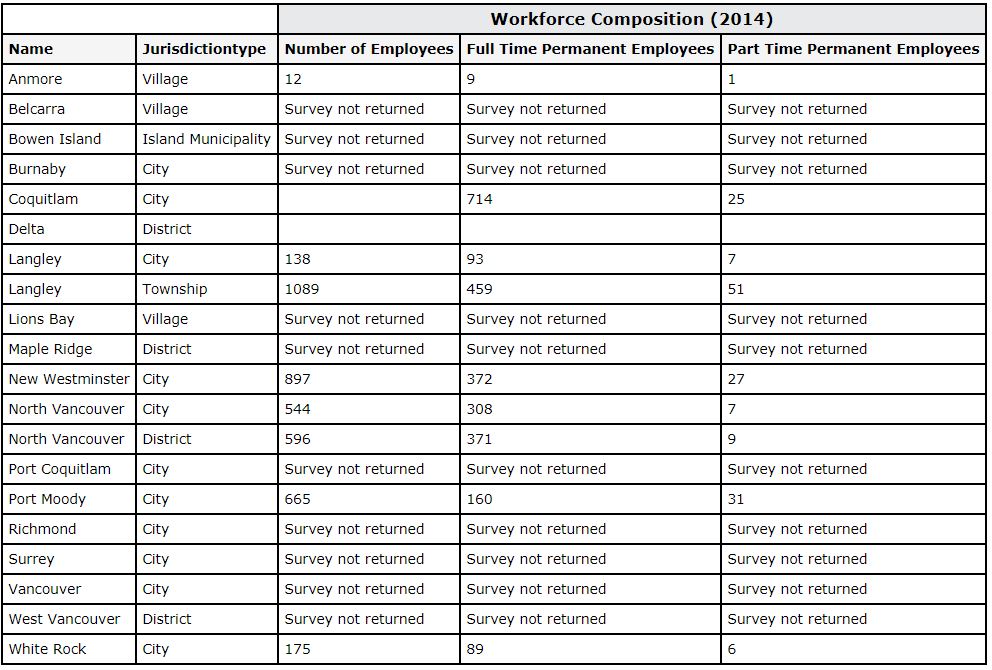
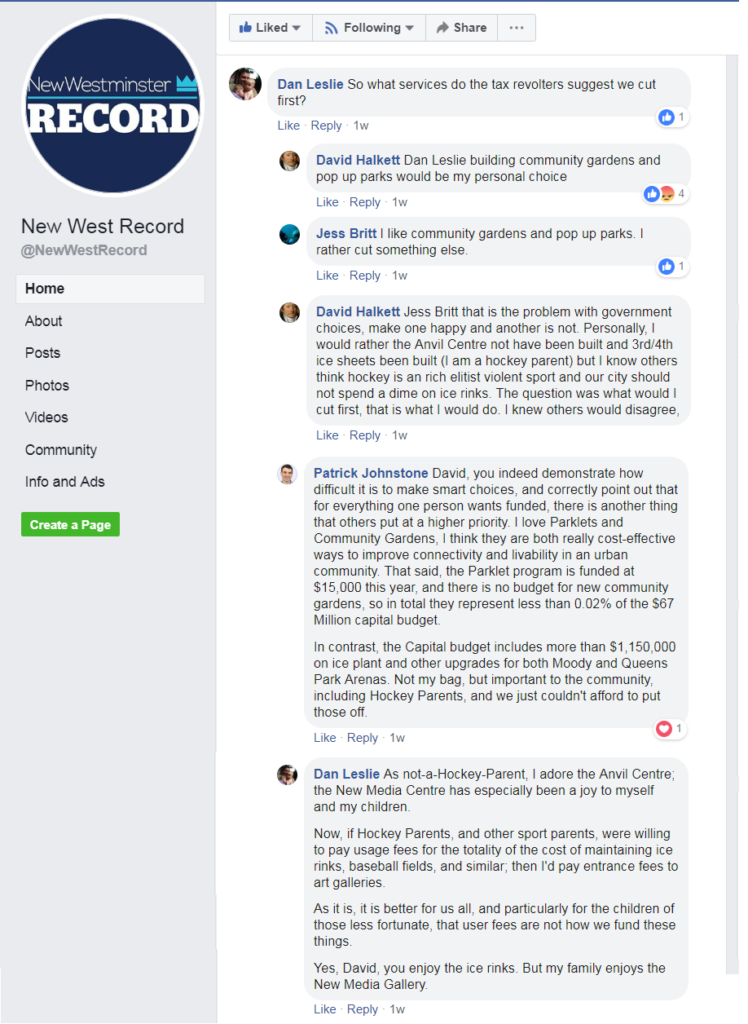

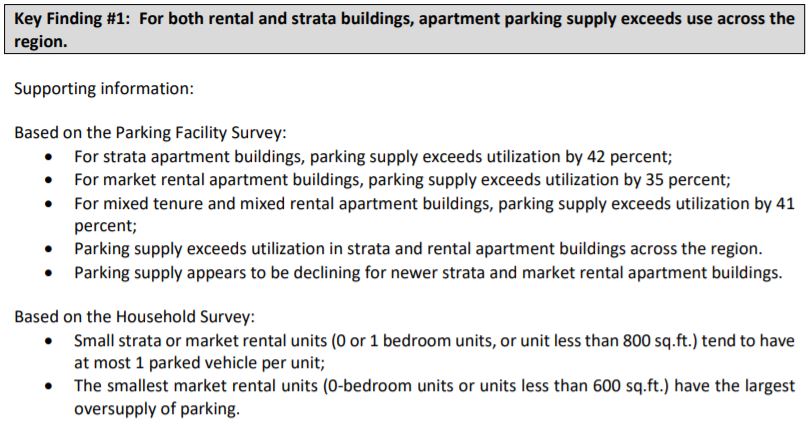
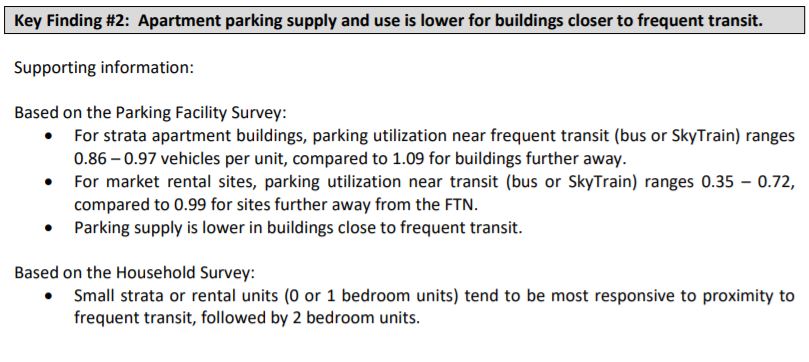
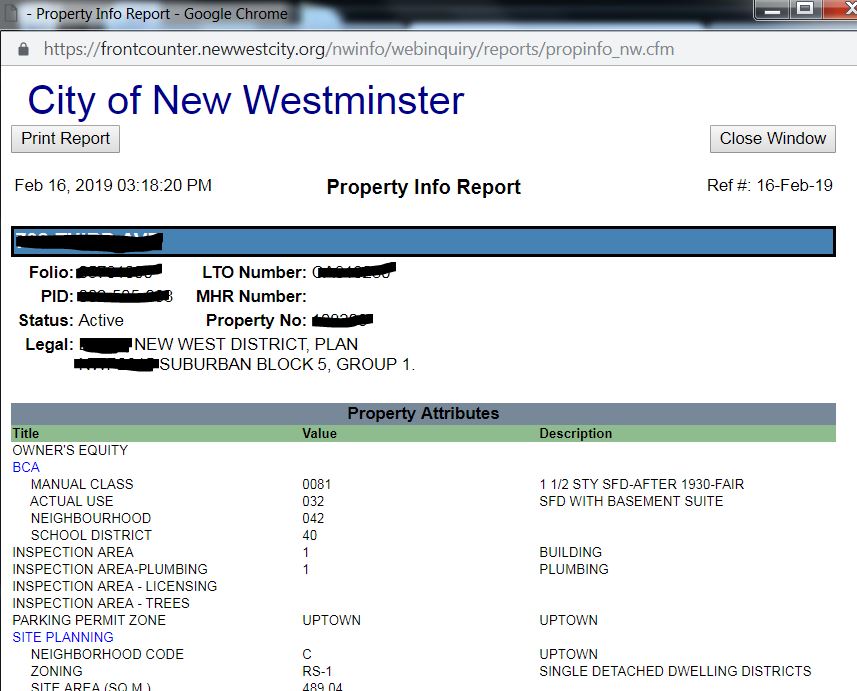
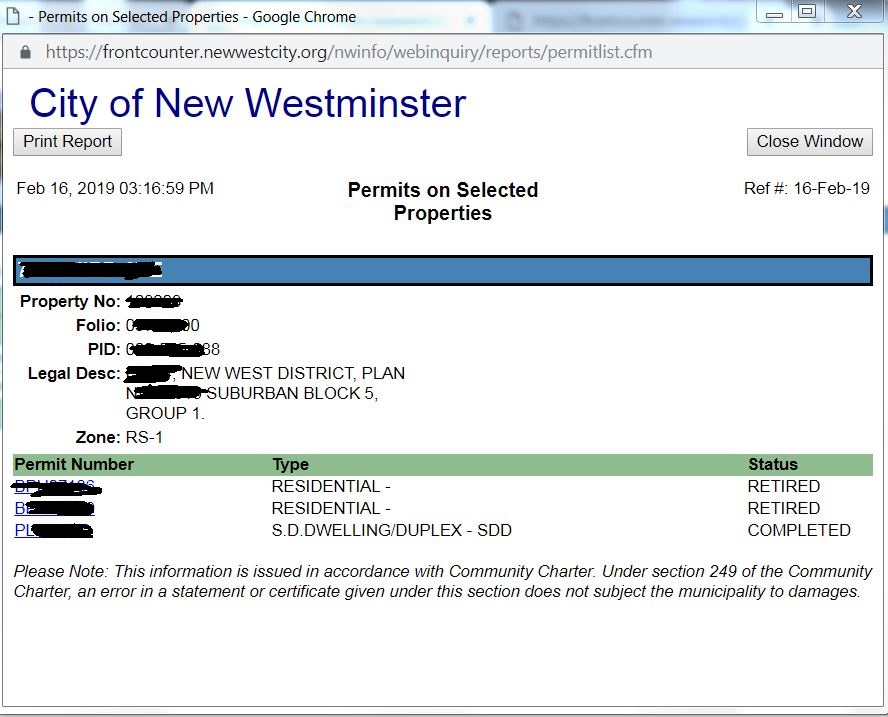 Here I can see three permit numbers: the original building permit was from 1940, my rear sundeck was built in 1987 with a valid permit, and I can see the permit I took out for my bathroom renovation project I did two years ago.
Here I can see three permit numbers: the original building permit was from 1940, my rear sundeck was built in 1987 with a valid permit, and I can see the permit I took out for my bathroom renovation project I did two years ago.